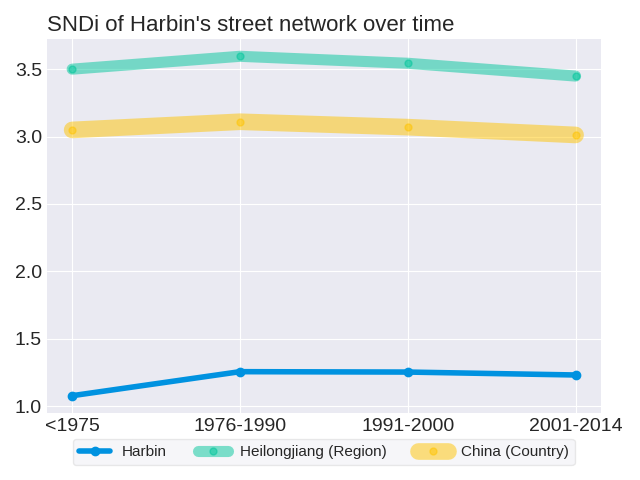Harbin: city in Heilongjiang, China


What exactly constitutes the spatial extent of the city? For these aggregations, we used the Global Human Settlement Layer Urban Center Database (GHS-UCDB) to define the boundaries of the city. These cities -- or urban centers -- cover areas that are densely populated and built-up, and so may extend beyond the spatial borders of these cities that we may be familiar with. The GHS area is shaded in blue.
View Harbin, China on the sprawlmap


Most recent snapshot: Taking into account the entire (i.e. aggregate) street network in Harbin as of 2014, the overall level of street-network sprawl is 1.23, which is relatively well-connected.
Trends in street network construction: The SNDis of street construction for the respective time periods are 1.08, 1.55, 1.4 and 0.79. Street construction in Harbin increased in disconnectivity initially but has since improved. The streets constructed in 1976-1990 were the most disconnected.
Quantity of street network construction: The street network in Harbin spans a total of 2105 kilometers. It is dominated by roads constructed prior to 1975. These roads have an SNDi of 1.08, which is relatively well-connected.
Effect on the aggregate network: New construction in each period adds to the total stock of streets, but does not change streets that have already been built. Therefore, it has a limited effect on the street network as a whole. The SNDis of the aggregate street network in the respective time periods are 1.08, 1.26, 1.25 and 1.23. The aggregate street network in Harbin increased in disconnectivity initially,but the trend has turned around after 1990.

Harbin and Heilongjiang follow the same trend in the disconnectivity of their street network constructions. The SNDi for both of these peaked in 1976-1990.
How do development practices in Harbin fare in comparison to others in Heilongjiang? Most recently in 2001-2014, street construction in Harbin was the 20th-most disconnected out of the 52 cities in Heilongjiang. Its position in the ranks since 1975 has risen; relative to other cities in Heilongjiang, street construction in Harbin has become more disconnected. Harbin ranked 36th in 1975, 31st in 1976-1990, 16th in 1991-2000 and 20th in 2001-2014.
Harbin and China do not follow the same trend in the disconnectivity of their street network constructions. The SNDi in Harbin peaked in 1976-1990, while the SNDi of street constructions in China followed a zig-zag trend with an overall decrease.
How do development practices in Harbin fare in comparison to others in China? Most recently in 2001-2014, street construction in Harbin was the 1081st-most disconnected out of the 1651 cities in China. Its position in the ranks since 1975 has fallen; relative to other cities in China, street construction in Harbin has become more connected. Harbin ranked 801st in 1975, 840th in 1976-1990, 660th in 1991-2000 and 1081st in 2001-2014.

Harbin and Heilongjiang follow the same trend in the disconnectivity of their aggregate street networks. The SNDi for both of these peaked in 1976-1990.
To date, Harbin is the 34th-most disconnected out of the 52 cities in Heilongjiang. Its position in the ranks since 1975 has risen; relative to other cities in Heilongjiang, the street network in Harbin has become more disconnected. Harbin ranked 36th in 1975, 35th in 1976-1990, 33rd in 1991-2000 and 34th in 2001-2014.
Harbin and China follow the same trend in the disconnectivity of their aggregate street networks. The SNDi for both of these peaked in 1976-1990.
To date, Harbin is the 1096th-most disconnected out of the 1651 cities in China. Its position in the ranks since 1975 has fallen; relative to other cities in China, the street network in Harbin has become more connected. Harbin ranked 801st in 1975, 1012th in 1976-1990, 1030th in 1991-2000 and 1096th in 2001-2014.
As of 2015, Harbin had a built-up area of 262.31 square kilometers, and a population of 4130656 people.
These are some other cities with approximately the same population: